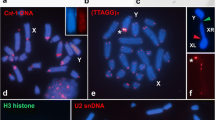Abstract
The three endemic species of the Australian genusTolgadia are all distributed in the northern tropical and subtropical areas. They are distinguishable both on morphological and cytological grounds. All three have a derived neo XY♂, neo XX ♀ sex chromosome system involving distinct elements of a basically 11-membered autosome set, namely\(\) (spacies-1)\(\) (bivittata) and\(\) (infirma). Additionallybivittata is homozygous for two autosomal fusions involving\(\) and\(\) giving 2n=18 as compared to the complement of 2n=22 present in the other two species. Two of the species,bivittata and species-1, have a comparable mean cell chiasma frequency despite their difference in chromosome number. That ofinfirma is significantly higher. Coupled with this, some of the populations ofinfirma are polymorphic for supernumerary heterochromatic segments, principally on the smallest autosome. Such segments increase the mean cell chiasma frequency still further. Thusinfirma, which is the least habitat restricted despite its brachypterous nature, not only has the highest mean cell chiasma frequency but, in addition, has at its disposal a polymorphism capable of magnifying this difference.
Similar content being viewed by others
References
Diaz, M.O., Saez, F.A.: DNA-synthesis in the neo-X neo-Y sex determination system of Dichroplus bergi (Orthoptera:Acrididae). Chromosoma (Berl.)24, 10–16 (1968)
Hewitt, G.M., John, B.: Inter-population sex chromosome polymorphism in the grasshopper Podisma pedestris. II. Population Parameters. Chromosoma (Berl.)37, 23–42 (1972)
John, B.: The cytogenetics of grasshoppers and locusts II. The origin and evolution of supernumerary segments. Chromosoma (Berl.)44, 123–146 (1973)
John, B., Freeman, M.: Causes and consequences of Robertsonian exchange. Chromosoma (Berl.)52, 123–136 (1975)
John, B., Hewitt, G. M.: Inter-populations sex chromosome polymorphism in the grasshopper Podisma pedestris. I. Fundamental Facts. Chromosoma (Berl.)31, 291–308 (1970)
Key, K.H.L.: Orthoptera. In: The insects of Australia, p. 323–347. Melbourne: University Press 1970
Rhen, J.A.G.: The grasshoppers and locusts (Acridoidea) of Australia. III. Family Acrididae: subfamily Cyrtacanthacridinae. Tribes Oxyini, Spathosternini and Praxibulini. Melbourne: Commonw. scient, ind. Res. Org. 1957
Saez, F.A.: Gradient of the heterochromatinisation in the evolution of the sexual system “neoX-neoY”. Portug. Acta Biol. A,7, 111–138 (1963)
Author information
Authors and Affiliations
Rights and permissions
About this article
Cite this article
John, B., Freeman, M. The cytogenetic systems of grasshoppers and locusts. Chromosoma 55, 105–119 (1976). https://doi.org/10.1007/BF01798343
Received:
Accepted:
Issue Date:
DOI: https://doi.org/10.1007/BF01798343




